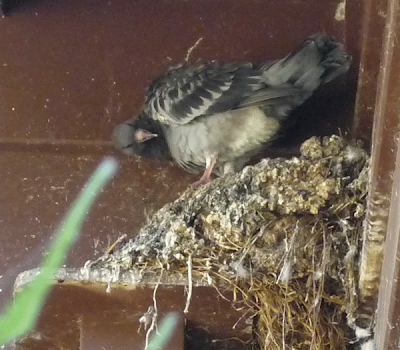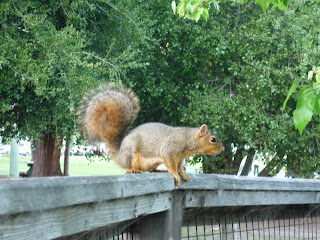As if to flaunt the fact that feathers are unique to them, birds use their feathers almost constantly, mostly to fly away from people who are jealous of their featheriness and trying to take some for themselves. Although feathers are durable, all that evasive action takes its toll, and eventually the feathers get all ratty. The edges fray and the fibers don't clump together so well anymore. Birds that get their food from the local sandpaper factory need to replace their feathers constantly, but for most birds, the process happens one or two times a year. Some birds molt into and out of breeding plumage, like renting a tux for prom night. Others look the same before and after, replacing a few worn feathers at a time until they have an all new set.
Ducks and geese undergo "synchronous molting," which is something like going on What Not to Wear, where they throw all your old clothes away into a giant trash can, your closet is empty, and you feel Very Cranky. Geese take about two to three weeks to fill the metaphorical trash can with their old feathers, but you can bet that they are also Very Cranky while it's happening.

Each summer, the number of geese at the lake increases from a few hundred to almost 2,000, according to surveys by the
Lake Merritt Institute. They come seeking to leave their gloppy green poop on our clean sidewalks. Also they need a safe place to hang out while Stacey and Clinton pick out their new outfits for them.

How can you tell if a goose is molting, or how likely it is to hiss at you and make fun of your glasses to hide its insecurity about being flightless? An easy way is to look at the butt. A goose which has shed its primaries will have a fully visible tail, and you can also see a white butt stripe as the goose shakes its booty. Two of the geese in the picture below are of the extra cranky no-primaries variety. The third goose, closest to the camera, has already grown new primaries, and they come to a point above the tail, giving its butt a kind of 1950s pointy Maidenform bra look.

Another way to tell whether a goose's feathers have that not-so-fresh feeling is to look at the color at the edge. A new feather will be uniformly dark; an old feather will have a pale and raggedy edge. You might have to click the picture below to see, but like a well-loved stuffed animal that is about to become Real, this goose has some ratty secondaries (and some new primaries).

Some geese have problems as young birds: their wingbones distort and their feathers grow in all crazy. This disease is optimistically called "
Angel Wing" and is believed to occur when developing youngsters eat too much protein, e.g. Cool Ranch Doritos. Another argument against feeding birds human food...

Such birds are sad to watch, but overall their chances of survival at the lake are probably better than elsewhere--with islands to hide on and entire lawns of grass to eat, it's practically as cushy as a Motel 6.
And, as you'll see in the next post, there's WAY more hanky panky at the lake than in a lousy old motel!
 A recent study indicated that mockingbirds can recognize individual humans who mess with their nests. I wonder if pigeons can do the same?
A recent study indicated that mockingbirds can recognize individual humans who mess with their nests. I wonder if pigeons can do the same? Anyway, I FINALLY caught one in the act, lasciviously regurgitating crop milk right in public. Yes, that blurry yellow thing on the right is the baby.
Anyway, I FINALLY caught one in the act, lasciviously regurgitating crop milk right in public. Yes, that blurry yellow thing on the right is the baby. Well, I couldn't get any good pictures of the developing baby, but luckily, Wikipedia has some. And boy are they gross. Baby pigeons are even freakier than other baby birds, due to the developing cere, or "freaky bump on top"! What is that thing for? I'll get back to you.
Well, I couldn't get any good pictures of the developing baby, but luckily, Wikipedia has some. And boy are they gross. Baby pigeons are even freakier than other baby birds, due to the developing cere, or "freaky bump on top"! What is that thing for? I'll get back to you.
 Check the tail flaps...
Check the tail flaps... ...warm up the wings... and...
...warm up the wings... and... ...FLAPPITY!
...FLAPPITY! Uhm, yeah. False alarm. I'm not flying anywhere just yet.
Uhm, yeah. False alarm. I'm not flying anywhere just yet.











































